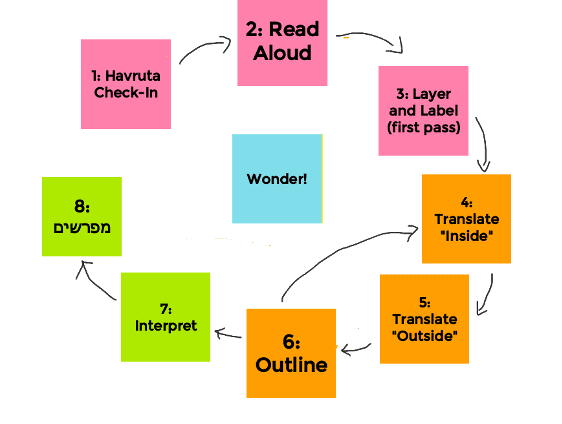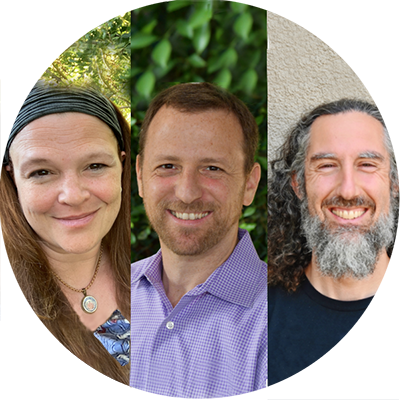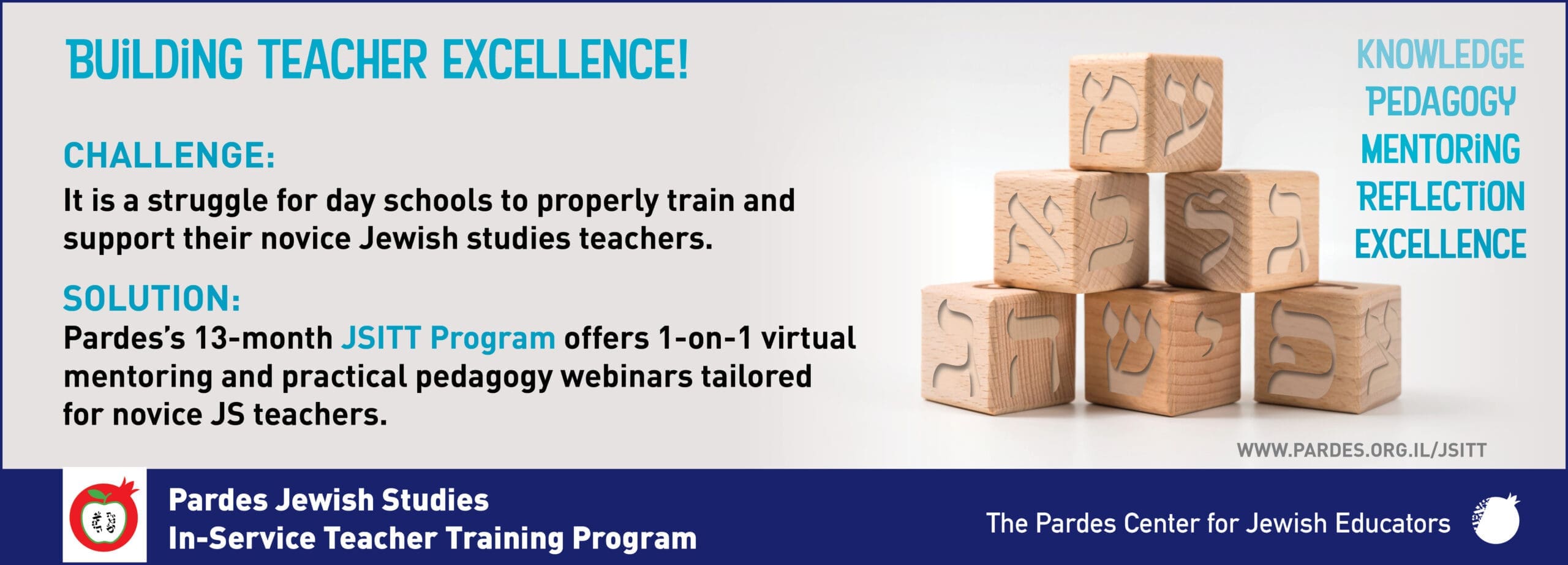Replacing Relevance with Relationship

Devin Maimon Villarreal is a senior coach and program manager for Pedagogy of Partnership at the Hadar Institute. Rabbi Villareal previously served as a classroom teacher in both Orthodox and community day schools, and was awarded the Covenant Foundation’s Pomegranate Prize for emerging Jewish educators. He was ordained by Yeshivat Chovevei Torah as well as Rabbi Nathan Lopes Cardozo. A graduate of UCLA in the Study of Religion, he also holds a Master’s Degree in Teaching from the American Jewish University.



Miriam-Simma Walfish is faculty at Hadar and a Senior Coach for Pedagogy of Partnership. Rabbi Walfish holds a PhD in Rabbinics from Harvard University. Her interests include rabbinic approaches to gender, parenting, and education, and she has published several articles. Rabbi Walfish has taught Tanakh, Talmud, and Jewish Law in numerous settings including the Conservative Yeshiva, Hadar, Harvard University, Hebrew College, and the National Havurah Committee’s summer institute.
A relationship to Talmud study is highly valuable to those who possess it. Few other activities manage to combine elements of intellectual inquiry, spiritual questing, and moral development in the almost alchemical way that the study of Talmud does. And yet, there are a number of hurdles students must overcome in order to develop an independent relationship with the Talmud. First and foremost, studying Talmud in the original Hebrew and Aramaic can feel scary to the uninitiated. Second, the logic of the Talmud is foreign to students at first. Finally, students may wonder what a text from 1500 years ago might have to say to them. If we want our students to develop their own independent relationships with the Talmud, we have to help them overcome their fears, provide them with tools for understanding the language, syntax, and logic of a Talmudic sugya, and help them engage in a fruitful dialogue with the text. This dialogue will help students view themselves as part of the interpretive tradition and will help them experience the dimensions of Talmud study that make it such a profound activity.
In order for students to develop this kind of dialogue with Talmud, they have to have the experience of encountering Talmud on their own, without the direct mediation of a teacher.
We believe that hevruta is the highest leverage modality to anchor this experience for students for a number of reasons: 1) Talmud has been studied in hevruta for thousands of years. Even if students haven’t been exposed to a traditional beit midrash environment, learning Talmud in the way it has been studied by its creators and greatest masters can provide students with a powerful feeling of authenticity. 2) Talmud is a dialogical text–studying Talmud in a hevruta can help students see themselves as continuing the dialogue on the page and bringing it to life. 3) Finally, as expressed by Pedagogy of Partnership, studying any text in hevruta helps students form strong relationships with their human and textual partners. Given the opportunity, students consistently articulate the value of learning in hevruta in terms of developing interpersonal skills that, in their words, bring you “past your own limits,” as well as understanding the skills in “ways you just can’t on your own.”
Why Study Talmud....
Talmud is a dialogical text. Its form therefore invites students into dialogue with our tradition. It can serve as a mirror, helping students articulate their Jewish identities by putting their self-conceptions and ideas about the world in conversation with rich conversations that happened in the past.


Talmud Hevruta Flow
In our introduction, we noted that in order for them to engage in fruitful Talmud study, we need to teach students to overcome their fears, provide them with tools for understanding, and help them engage in a fruitful dialogue with the text. The rest of this article will outline a recommended hevruta flow that students can practice that addresses each of these three areas. If students master the steps of this hevruta flow, they can approach any sugya with facility, knowing exactly what to do every step of the way.
Steps 1-3: Introductions
The first three steps in the hevruta flow (in pink) help students greet one another and invite the text to the table as a partner of engagement. This framing moves the Talmud study encounter away from a common default setting of the subject/learner studying an object/Talmudic text to one of dialogue between live partners, all with voices and experiences that require a foundational level of honoring.
Hevruta check-in—meet your human partner
At times, students in hevruta get into competitive relationships. Who is better at Talmud? What will each partner contribute? Providing students with a check-in ritual at the beginning of a hevruta session shows students that the hevruta relationship itself is important and is not just a means to the end of understanding what the sugya means.
Some possible prompts for this check-in include:
- How are you doing today?
- What skill would you like help with today?
This kind of step reinforces the relational dynamic of Talmudic study. It reminds students of the opportunity they have of learning not just on their own, but with another person, who by their mere presence activates elements of the encounter that would be absent otherwise.
Read the sugya aloud, layer, and label—meet your sugya partner
These steps invite the text of the Talmud to the table as a partner in the hevruta. Students take turns reading the whole sugya aloud in the original. Practicing reading a sugya aloud will build students’ fluency such that eventually this stage will occur with greater comprehension. Teachers can explain to students that the goal at this point is not to understand the sugya, but to start to notice patterns and structures.
Why Study Talmud....
Studying Talmud provides high school students with the opportunity to explore and connect with the bigger picture. They learn the how and the why about so many different mitzvot, something which is crucial to their growth, not only as independent learners but also as they build the foundations for their own spiritual lives. …
As they read, students identify structural terms. There are two types of structural terms in the Talmud. First, there are terms that indicate when the Talmudic editors are drawing upon earlier sources—biblical verses, mishnayot, baraitot, and amoraic statements. Students can mark these earlier sources visually at this stage. Visually marking these sources can serve the purpose of helping the text become less scary for students even before they unpack it. We call this step layering because it helps surface the underlying chronological layers of the sugya. This step can be grounding for students because almost every sugya contains this earlier material as part of its discussion so students can quickly become familiar with the terms that introduce them.
Some teachers may choose to have students then identify a second kind of term, which is technical Talmudic vocabulary, and use this vocabulary to label the logical steps of the sugya. In order to scaffold the labeling of the sugya, teachers will need to provide students with a list of terms to look up in the Frank dictionary—these are not apparent for the novice Talmud student. Students circle these words and phrases, look them up in the dictionary, and use the definitions to label the steps of the argument as follows: Statement, Question, Answer, Challenge, Resolution, and Evidence.
Note: Some students may not have the patience for this dictionary work at this stage of minimal comprehension. If that is the case, the teacher can defer the labeling of the logical steps of the sugya to the stage at which they are translating and outlining it.
All of these preliminary steps help students open up their hevruta encounter with the text of the Talmud. Framed in relational terms, this stage is akin to being introduced to a new acquaintance. You now know what this person looks like and what their name is, but if you want to really get to know them, you have to engage in deeper conversation. It is this frame that brings the Talmudic sugya to life and lends these steps deeper purpose.
Steps 4-6: Translate “inside,” translate “outside,” and outline
Whereas the first three steps of the hevruta are designed to get students acquainted with the sugya as a whole on a surface level, steps 4-6 are where the students unpack the flow of the sugya, getting inside its details. In order to do this, students translate and outline each logical unit, repeating steps 4-6 for each.
“Inside” translation
In order to translate a line of text effectively, students need to account for each word and grammatical element. If students jump too quickly to try to generate a polished translation, they often overlook key elements, leading to an incorrect translation. In addition, being faced with a line of Hebrew/Aramaic text and being asked to generate a translation can be overwhelming for some students. To address both of these concerns, we first ask students to translate each word on its own, and not change the line’s original syntax. We tell them that at this stage they are cracking a code and it need not make sense. We sometimes call this inside translation activity “Yoda translation” since it may sound to students like the syntactically absurd speech of Yoda in Star Wars. Asking students to do this can also be an equalizer—any student, no matter their Hebrew level, can learn to look up some words in a dictionary and create a Yoda translation. Even students with minimal Hebrew can see Talmud study as a code to crack, a code that they have the tools to access independently.
Note: Inside translation can also help with differentiation—a teacher can provide students with some inside translations filled in or with a detailed glossary that they can use to fill in an inside translation. This enables students to still be full participants in Talmud study and experience the act of translation even if they lack the vocabulary to do this step fully independently.
“Outside” translation
Once students have recorded an inside translation, they can look at all the pieces they have collected and begin to make sense of these pieces. At this point, their task is to create a translation that includes all of the textual elements but makes sense in English. This is an interpretive task because there are often multiple possible ways to make sense of an inside translation, some of which will be more compelling than others. Because of this, partners should take turns sharing their ideas. By providing structures for both peer partners to listen and articulate with one another around a polished translation, possibilities for meaning making emerge that would not have been possible by one’s self.
Outline
In classes newer to Talmud study, this would be a good place to check in with students, either individually or as a group, to make sure that each student has a working understanding of the words and phrases of the sugya. Having spent time translating, students will be inside the text and better equipped to unpack the underlying logic of the Talmudic sugya. With this foundation, they are equipped to articulate to one another how the steps of the sugya fit together. If students labeled the steps of the argument in step 3, they now return to these labels. Their task at this point is to explain how this step in the argument flow works—if they have identified it as a question, what is it asking? If it is an answer, how does it answer the question? If it is a challenge, how does the challenge work? What precisely is the premise of the challenge? Students may use tools to assist them in outlining the sugya, such as the Frank dictionary, Rashi, and Rabenu Hananel.
The hevruta partnership is essential at this stage as students help one another articulate how the sugya works. This is also an interpretive exercise, as there can be multiple ways of understanding how each step functions (as we can see from multiple interpretations of sugyot present in the mefarshim). It is very often the partnership between the peer hevruta partners that brings more of these possibilities to the fore, with each hevruta partner making unique connections about the text they are working through together. Peer hevruta partners co-construct a meaningful map of the sugya’s flow and its implications for the topic it is discussing. Additionally, mastering this stage helps students immerse themselves in the logic of the rabbis and feel like they can engage in dialogue with the rabbis because they are immersed in their language and style.
Steps 4-6 are cyclical and need not happen in a rigid order; a student’s polished translation might cause them to refine their inside translation. Their attempt at labeling might cause them to question their polished translation—all of this is okay and is simply part of the process of unpacking a sugya for the first time.
It is important to note here the pervasive value of the peer partners engaging in a process of “wondering” (see below), taking what they notice about the text and allowing it to generate curiosities and questions that serve as a driver for polished translations, meaningful outlines, and possible implications.
Steps 7-8: Interpret / mefarshim
The Talmud is full of big human questions that high school students love thinking about: For instance: What does a just society look like? (Sanhedrin) How should we structure our days to make space for the divine? (Berakhot) In the “interpret” step, students can take a step back and zoom out, exploring and evaluating how the rabbis’ discussion addresses these questions through the sugya under discussion. This stage can be done individually or as a full group and serves to connect students with the rabbis in a dialogue about timeless questions that students will find relevant. The key at this stage is to continually invite students to engage with the perspectives in the text and equally, to connect students to one another, and to bring to the table each student’s encounter with the text. We want students to embody the following identity statements: “The Talmud can help me think about my life in a more nuanced way” and “I can bring my life experiences and perspectives to bear on the discussions in the Talmud.” When they are inside the language and logic of a sugya and can begin to ask questions of the rabbis and fine-tune their own perspectives in dialogue with a sugya, these identity statements come to life.
Once students have developed their own interpretations, mefarshim can be a force for deepening those interpretations. Mefarshim can also help expose some of the big human questions that the sugya is dealing with. Because working with mefarshim requires its own skillset, the teacher may initially need to introduce mefarshim in the full group rather than as part of the hevruta assignment.
The Role of Wonder
A dynamic that informs all of the steps above and to which we alluded earlier, is that of “wonder.” When a learner hears the text’s voice in a partnership dynamic, it creates the opportunity to notice things that stand out in the text’s statements. This then gives rise to wonder, “which definition fits here best?” “what did the text mean when it said x?” “Is what the text saying here connected to…?” “Is it possible that the text is telling us…?” This kind of wondering emerges from the text and sends learners back into the text to discover more. Additionally, what students notice and wonder will often be unique, thereby helping one another appreciate new things about the text. Other times, what they notice and wonder about will overlap, which creates its own kind of invigoration to explore more deeply.
Conclusion
A good relationship is one that nourishes those in it and pushes them to grow. Both the content and process of Talmud study can foster that dynamic. However, such a relationship isn’t formed by simply putting students and text together. The hevruta structure we’ve outlined here intentionally nurtures the kind of relationship in which learners and text can all equally be described by the words: “One who dwells in the gardens; friends attend to your voice; let me hear it” (Shir HaShirim 8:13).



Miriam-Simma Walfish is faculty at Hadar and a Senior Coach for Pedagogy of Partnership. Rabbi Walfish holds a PhD in Rabbinics from Harvard University. Her interests include rabbinic approaches to gender, parenting, and education, and she has published several articles. Rabbi Walfish has taught Tanakh, Talmud, and Jewish Law in numerous settings including the Conservative Yeshiva, Hadar, Harvard University, Hebrew College, and the National Havurah Committee’s summer institute.



Devin Maimon Villarreal is a senior coach and program manager for Pedagogy of Partnership at the Hadar Institute. Rabbi Villareal previously served as a classroom teacher in both Orthodox and community day schools, and was awarded the Covenant Foundation’s Pomegranate Prize for emerging Jewish educators. He was ordained by Yeshivat Chovevei Torah as well as Rabbi Nathan Lopes Cardozo. A graduate of UCLA in the Study of Religion, he also holds a Master’s Degree in Teaching from the American Jewish University.
Reach 10,000 Jewish educational professionals. Advertise in the upcoming issue of Jewish Educational Leadership.
Do you want to write for Jewish Educational Leadership? See the Call for Papers for the upcoming issue.


FROM THE EDITOR: Fall 2023
Fascinating. Infuriating. Uplifting. Complex. Boring. Inconsistent. Logical. Brilliant. Eclectic. Irrelevant. Compelling. Frustrating. Inspiring. Ancient. Contemporary. The Talmud evokes all the above, and more. I vividly remember my first encounter with Gemara. I must have been ten years old, and my family was in a bungalow colony in the Catskills. Rabbi Cohen taught Gemara to the older boys, of which I was not, but I asked permission to sit in and listen. I loved following the discussions and debates, even though I couldn’t read any of it and retained none of the content.


The Block Method for Teaching Gemara
By its very nature, teaching Gemara seems to defy everything we know about education. When we teach math, or language, or anything else, we start with the simple and easy-to-grasp aspects of the study area and gradually increase the level of challenge and difficulty. For example, we begin with addition and slowly move on to subtraction, multiplication, and division. We certainly don’t touch algebra until these are firmly in place. One couldn’t imagine a math class that requires knowledge of Pythagoras’ theorem presented to a class that has not yet mastered multiplication.


The Puzzling Talmud
A sixteen-year-old American Jewish day school student named Brandon (a self-chosen pseudonym) reports that he likes studying Talmud. What does he like about it? “I like the process,” he says. “It is kinda like a puzzle, that you have to get each word, and fill it in so it creates the whole text.” Brandon approaches his study of Talmud knowing that it’s going to be hard. Every word might take some effort to decode. Eventually, however, he can put it all together.


A Multidimensional Approach to Teaching Rabbinics
Pressman Academy is an early childhood through 8th grade school in Los Angeles serving a religiously diverse group of students. The school’s Judaics program, which includes Hebrew language, Jewish history, Tanakh, and daily prayer, affords a maximum of two weekly periods to teaching Rabbinics (in grades 5-8), presenting a significant challenge of what to include and how to approach it.


The Sanhedrin is in Session: Experiencing Rabbinic Literature
On Tuesday morning Rabban Gamliel called the gathered people to order. A letter had arrived from a northern district court in the Galilee which required the attention of the Sanhedrin. Rabban Gamliel took his seat at the head of the semi-circle of esteemed Rabbinic colleagues. R. Yehoshua sat on one side of him and R. Eliezer sat on the other.


Teaching Talmud in Secondary Schools: Masorah and Modernity
Teaching of Talmud in traditional secondary schools has been a conundrum from the day it was decided to teach Talmud as part of the standard Jewish studies curriculum. Programs for yeshiva high school graduates in Israel and around the world are consistently populated by an overwhelming percentage of students who, even after six years of multiple weekly hours of Talmud instruction in secondary schools, are helpless in the independent study of Talmud. These students are successful independent learners of advanced mathematics, natural sciences, complex technology, and even humanities, but in Talmud, they require an embarrassing degree of spoon-feeding.


Pre-Mishnah: The Missing Link
I teach 5th grade Judaics at Fuchs Mizrachi School, a Modern Orthodox Zionist school (Cleveland). Upon entering the world of Torah SheBe’al Peh, a student is first greeted by the Mishnah—a complex and sophisticatedly interwoven compendium of Jewish law and wisdom. Students struggle to understand its relevance, how and why it was created, and its importance to the scope of their Torah learning. They ask, “Why are we learning Oral Torah?” and “Why should I care?” but underlying those questions is the more fundamental, “What is the Oral Torah?” While some choose to address this piecemeal over the span of many years, I believe that it is important to address it up front, in an organized manner.


Anatomy of a Gemara Lesson
You have been there, too, right? You thoroughly prepared a Gemara lesson by formalizing how you will explain the shakla vetarya, you concocted attention-grabbing examples and cases, charts to organize the conflicting opinions, and provided a translation and question practice worksheet. You slowly read the Gemara aloud while students annotated the text or completed linear translation sheets. You patiently and clearly explained the concepts and reasoning on a first, second, and even third pass of the reading.


Making the Case for Agada
The rabbis of the Talmud were intentional and thoughtful educators; an example of their consummate pedagogic skill is the way they interspersed narratives into their halakhic writings and teachings. Their use of agadot is an effective teaching tool because, simply put, people love stories. We evolved to tell stories, to become compelled by stories, to connect to the characters, drama, and tension in stories. Stories draw in our students and they have the power to make them care.


Tokhehah Leshem Shamayim
One day, in a 7th grade lesson during our unit on tokhehah (the mitzvah of rebuke), a student shouted out from across the classroom: “This is tokhehah leshem shamayim!” In this moment, with one eloquent and original phrase, this 7thgrader had connected the learning in our current unit of tokhehah with the concept of leshem shamayim (for the sake of heaven) from our previous unit of mahloket (disagreement). This delighted us because it showed that the concepts of mahloket we had been teaching were not just retained for the duration of our unit, or for a test, but were concepts students internalized, held on to, and could apply to new settings and used in unique ways.


Extending the Reach of Rabbinics
Morah M.’s 5th-grade class is curating a museum exhibit showcasing artifacts that represent family legacy and tradition. The items are described on a placard that explains: These candlesticks were my Bubby’s and now my mother and I use them for Shabbat. When I chose them, I thought of the story about R. Yehuda HaNasi that we learned (Ketubot 103a). Before he died, he told his family that they should continue to set the table the same way, keeping the lamp in its usual place. We’re sort of doing the same thing when we use Bubby’s candlesticks.


Talmud Education for Diverse Learners: Taking the “Long but Short” Road
Teaching Talmud to weaker students can present many challenges not typically found in traditional Gemara classes. Navigating a text in a foreign language, especially one with the unique structure and rules of the Talmud, can be daunting for those grappling with language-based difficulties. Educators must realistically decide which teaching method—skill-based or discussion-based—will best set diverse learners up for success, and how demanding a Talmud course should be for students not likely to pursue this type of Torah learning in the future.


Teaching Talmud Guided by Essential Questions
Standing at the edge of the sea can be an awe-filled experience—the incomprehensibly vast expanse of water with no end in sight is both inspiring and intimidating. We would not consider entering it, whether to swim, sail, surf, cruise, or dive without proper preparation. Similarly, the Sea of Talmud is rich with information, personalities, debates, and much more. It, too, can inspire and intimidate with its vastness and complexity, and we should not expect our students to be able to jump in and navigate it without context and a roadmap. To prepare our students as they embark on their journey into the Oral Torah, we need to define our goals and our strategies for achieving them.


An Alternative Approach for Teaching Talmud
In my first year of teaching, I taught a student whom we will call Yossi. From the time he started 1st grade reading groups, Yossi was placed in the lowest track. This pattern persisted through my 11th grade Gemara class. A few weeks into the first semester of 11th grade, Yossi approached me after class to ask me a burning question which he was embarrassed to ask in front of his peers. He asked, “Who is Rabbi Baraita?” I said, “What do you mean?” He responded, “My past teachers kept explaining ‘the Baraita says…’ Who is Rabbi Baraita and why is he referred to as the Baraita?”


“Wait, What?!” Teaching Jewish Law in a Reform Jewish School
As a teacher at Rodeph Sholom School (RSS), I have for some time considered what it means to teach Torah SheBe’al Peh in a Reform Jewish independent school. What I offer here is a taste of how my colleagues and I have strived to shape our 7th grade Rabbinics unit so that it is aligned with our school’s mission and meets the needs of our specific community of learners. And while every school is unique, I am hopeful that the insights I’ve gained from teaching one unit on the development of Jewish law are instructive for any Jewish day school grappling with teaching Torah SheBe’al Peh.


A Learner-Centered Approach to Teaching Gemara
Traditional methods of teaching Gemara, such as hevruta learning followed by an interactive shiur, have stood the test of time. When teaching beginner students, however, this approach is less common, given their lack of prior knowledge or skills. As a result, many teachers prefer a frontal approach, perhaps projecting the daf on the SMART board and presenting the text phrase-by-phrase while students take notes between the lines of the traditional Vilna text. If hevruta time is used, it is often for the students to review material rather than for them to try to decipher the text. In this article, we are going to propose a method for using a modified version of the traditional approach which can be used for learners starting out on their Gemara learning careers.


Why Learn Talmud?
Some of the articles in this issue describe the joy of studying Talmud, others break down the complex processes to make it more accessible to students or to enable the students to engage with it meaningfully. And just to make sure that we covered the bases of both the how and the why of Talmud study, we asked our authors to weigh in separately on the question: “Why do you think that day school students should be learning Gemara/Rabbinics?” We invite you to join that discussion.
Fall 2023 Journal Credits
JEWISHEDUCATIONALEADERSHIP
Jewish Educational Leadership is a publication of The Lookstein Center for Jewish Education of Bar Ilan University.
Chana German, Executive Director
JOURNAL STAFF
Hyim Brandes | Editor
Zvi Grumet | Editor-in-Chief
Chevi Rubin | Editor
Shani Sicherman | Copyeditor
Please send correspondence regarding journal content to zvi@lookstein.org.
The Lookstein Center publications present a variety of viewpoints. The views expressed or implied in this publication are not necessarily those of the Center.
EDITORIAL OFFICES AND ADVERTISING
The Lookstein Center for Jewish Education
Bar-Ilan University
Ramat Gan 5290002 Israel
Tel: +972-3-531-8199
US: +1-646-568-9737
www.lookstein.org
© 2023 by The Lookstein Center for Jewish Education.
All rights reserved.





